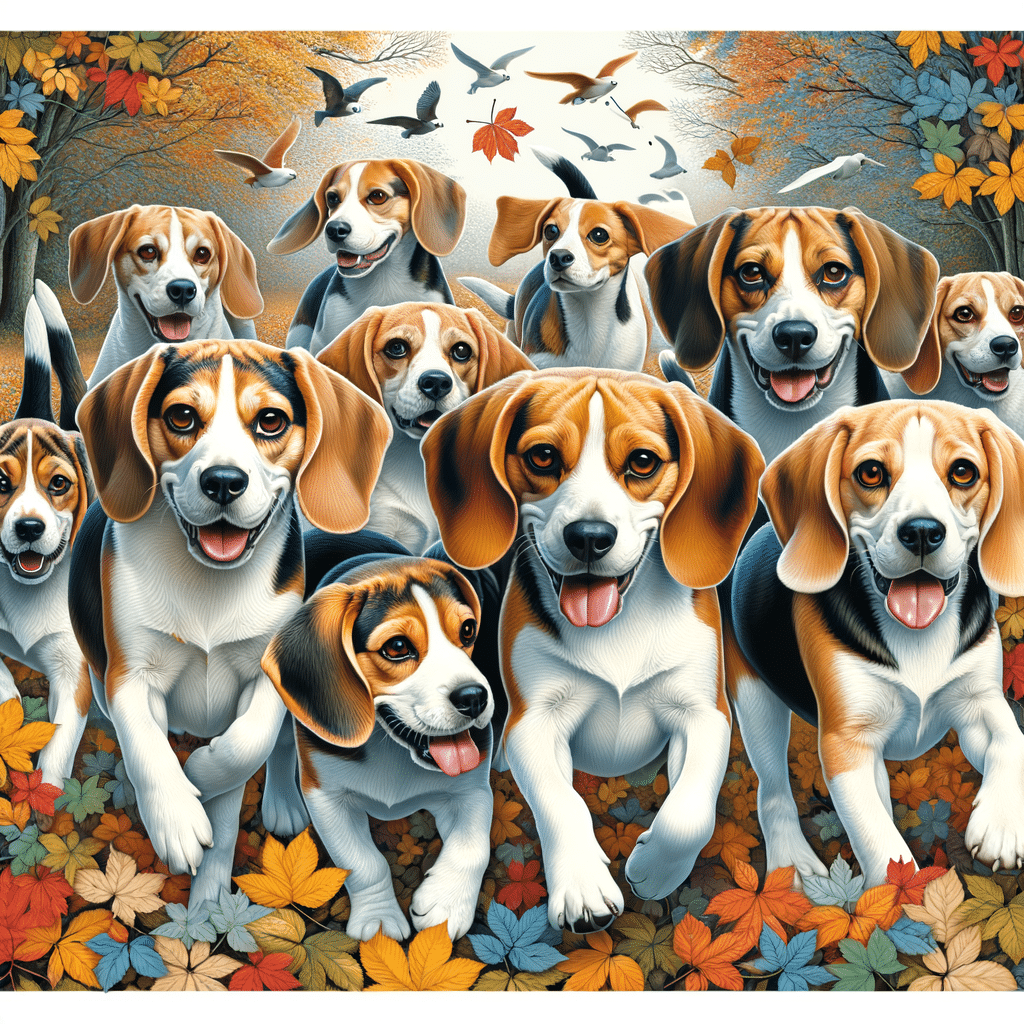The beagador, a beagle and black lab mix is a crossbreed that inherits traits from its purebred parents. This designer dog blends the traits of two popular dog breeds–the friendly and highly trainable nature of the labrador with the compact size and keen tracking abilities of the beagle. Despite no official recognition from purebred registries, Beagadors are popular because of their appealing mix of characteristics and training ease. They are very suitable family pets.
In This Article
This dog breed displays physical traits from both breeds. Beagadors often display the lab’s solid build and the beagle’s expressive face. Coat colors can vary, but many inherit the distinct black fur of the black lab parent.
On the temperament side, beagadors are known for their intelligence, energy, and affectionate nature. They are excellent companions for active families. Prospective beagador owners should take note of these animals’ need for engagement, physical activity, and proper exercise. Potential health concerns common to both parent breeds should also be understood.
Highlights
- The beagador blends the characteristics of the beagle and black lab, offering a friendly and energetic family companion.
- A mix of physical attributes from both breeds often exhibits the prominent black coat of the black lab.
- Beagadors require regular exercise and mental stimulation to maintain their health and happiness.
Breed Origins and History
The beagador is part of a growing interest in designer dogs. These animals are sought-after for their combination of traits from both popular dog breeds of their parents. Beagadors are not recognized as purebred by major kennel clubs such as the National Beagle Club.
Beagle Origins
The beagle is a breed with a rich history in hunting. This dog breed was initially bred for its keen sense of smell and tracking ability. Originating in England, beagles have been used for hunting rabbits and other games since Roman times, making them one of the oldest hound breeds. The American Kennel Club (AKC) recognized the beagle as a breed in 1885.
Labrador Retriever Origins
Labrador retrievers trace their history back to Newfoundland, Canada, where fishermen used them to help retrieve nets and fish that escaped from fishing lines. Labradors are renowned for their friendly disposition, intelligence, and work ethic. The AKC registered the labrador retriever as a breed in 1917.
Development of Beagle and Black Lab Mix
The beagador is a relatively recent addition to the designer dog mix, emerging in the 1990s in North America. Breeders aimed to harness the lab’s retrieving skills and the beagle’s exceptional scenting abilities. These dogs are often purposely bred to create offspring with desirable traits, such as the lab’s coat and the beagle’s size.
Recognition by Breed Clubs
While beagles and labrador retrievers are officially recognized by the AKC and other kennel clubs worldwide, the beagador is not. As a designer dog, it does not have official status with these organizations. However, it is often recognized by smaller hybrid and designer dog clubs. It’s important to note that beagadors are not eligible for purebred certification by these clubs due to their mixed-breed nature.
Physical Characteristics
The beagle and black lab mix is a blend of two popular dog breeds. It usually inherits the medium size of its beagle parent and the athletic build of its labrador parent. Physical characteristics can vary, but there are common traits that many beagadors share.
Size and Weight
Medium-sized is the hallmark of the beagle-lab mix. Beagadors typically reach between 17 to 22 inches in height. Adult beagadors usually fall within a weight range of 23 to 38 pounds, depending on factors like diet, exercise, and genetics.
Coat and Color
The beagle-lab mix inherits a short, dense coat that can display the double coat characteristic of labradors. This coat provides extra insulation and requires regular grooming. Shedding is consistent year-round, with seasonal peaks. The mix’s colors can vary, but they often exhibit the black coat color inherited from the black lab parent, often combined with the beagle’s classic white and brown markings.
Appearance
Beagadors have an affectionate expression, complemented by floppy ears. Their eyes are usually warm and inviting, mirroring the friendly nature of both parents. The mix tends to be robust and athletic, showcasing the labrador parent’s sturdy build while displaying the compact size of a beagle, making them an adaptable medium-sized dog.
Behavior and Temperament
Beagadors typically display intelligence and high energy from puppy to adult. This mix tends to have a winning combination of traits from both parents.
Personality Traits
Beagadors are often described as intelligent, affectionate, and active. They generally have a loving nature, which makes them excellent companions and enthusiastic play partners. They inherit the labrador’s loyal streak and the beagle’s curious and friendly disposition, creating a well-rounded personality.
Social Behavior
This mixed breed is known for being exceptionally social with family members and strangers. They thrive on interaction and are usually great with children and other family pets. Early socialization can help ensure their friendliness and good manners around humans and animals.
Activity Needs
Beagadors are energetic and active, requiring regular exercise to maintain their health and happiness. They benefit from at least 30 minutes to an hour of daily physical exercise. Activities include long walks, playtime in a fenced yard, or even agility training, which can provide the necessary mental stimulation.
Training and Intelligence
Known for their intelligence, beagadors are typically easy to train using positive reinforcement techniques. They may display a strong will, but with effective training, they can learn a variety of commands and behaviors. Keeping sessions engaging is key to managing their attention span, as they can become bored if not mentally stimulated.
Health and Care
When considering a beagle-lab mix, understanding health and care needs is essential for maintaining their well-being. This section provides insight into common health issues, exercise and dietary recommendations, grooming requirements, and tips for responsible breeding.
Common Health Issues
The beagador can inherit health problems from both parent breeds. Common dog health issues in this breed include:
- Hip Dysplasia: A hip joint malformation that can cause pain and arthritis.
- Elbow Dysplasia: Similar to hip dysplasia, affecting the elbow joints.
- Epilepsy: A seizure-inducing neurological disorder.
- Progressive Retinal Atrophy: A degenerative eye disease that often leads to blindness.
- Allergies: Beagadors may be prone to various allergies, affecting their skin and overall health.
Regular vet visits can help address these health issues early on.
Exercise and Diet
Beagle and black lab mixes are active dogs that require exercise to support their health and prevent behavioral issues. A balanced routine should include walks, playtime, and mental stimulation through training or interactive toys.
A proper diet is equally important and should consist of high-quality dog food tailored to their age, size, and energy levels. Feeding guidelines are as follows:
- Puppies: 2-4 meals per day
- Adults: 1-2 meals per day
Avoid overfeeding your pet to prevent obesity, which can exacerbate joint problems.
Grooming Needs
Grooming is vital for the health and comfort of beagadors. Their grooming needs include:
- Regular brushing (2-3 times per week) to manage shedding
- Monthly baths as needed
- Regular ear cleaning to prevent infections
- Nail trimming to avoid overgrowth and walking discomfort
Owners can keep their beagle-lab mix’s coat and skin healthy by maintaining a proper grooming schedule.
Tips for Responsible Breeding
Reputable breeders should prioritize the health and well-being of their beagadors by:
- Conducting pre-breeding health tests for common conditions such as hip and elbow dysplasia.
- Ensuring breeding pairs are free from inheritable conditions like epilepsy or progressive retinal atrophy.
- Providing a healthy environment and proper veterinary care for puppies and parent dogs.
Prospective owners should seek breeders who follow these practices to ensure a healthy pet.
Frequently Asked Questions
This section addresses common inquiries about beagadors and provides insights into their physical attributes, temperament, and health considerations.
What are the typical characteristics of a beagle and black lab mix?
The beagador typically inherits intelligence, affection, and energy from its parents. This medium to large dog exhibits a friendly disposition and is known for its loyalty and playfulness.
How large can a Beagador typically grow?
A beagador weighs between 30 and 60 pounds (13-27 kg) and stands approximately 13 to 22 inches (33-56 cm) tall at the withers. The exact size often depends on the dominant genes it inherits from its parents.
What is the average lifespan of a beagle and black lab mix?
The beagle-black lab mix generally enjoys a lifespan of around 10 to 15 years. Proper care, diet, and regular veterinary check-ups can influence their lifespan. Many owners invest in pet insurance to ensure consistent medical care throughout the dog’s life.
Are beagle-lab mixes suitable as family pets?
Beagle-lab mixes are well-regarded as family pets due to their friendly nature and compatibility with children. They often become an affectionate and devoted part of the family, thriving in a loving home environment.
What are the exercise requirements for a beagador?
Due to their energetic nature, beagadors require regular physical exercise to help maintain their physical health and mental well-being. Daily walks, play sessions, and mental stimulation are necessary to keep them happy and well-behaved.
What health concerns should potential owners be aware of in beagle and black lab mixes?
Potential owners should be mindful of genetic health issues such as epilepsy, hip dysplasia, and heart conditions. Regular health screenings and preventive care are essential to address these concerns.






